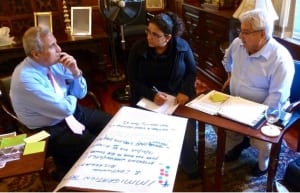This is the second in a series of three blog posts providing you with timeless steps for getting off to a good start with your own onboarding program. In Part One here we discussed leader listening and communicating.
- Set a Leadership Agenda

Jan Edgar Langbein, CEO, Genesis Women’s Shelter & Support of Dallas, TX – Photo: The Bush Center, Flickr CC
When things go wrong between CEOs and their boards, it’s often the result of a failure to reach a common understanding of what constitutes success. Co-create the new leadership agenda. One of the best tools we’ve seen is a simple but powerful template for articulating priorities and goals for the next 18 months, including the respective roles of the new leader, board, and senior staff in achieving them. (See the Sample Leadership Agenda in this article.) Some find it more effective during the first year to set milestones in smaller increments of three to six months. Pace yourself. Do not overcommit yourself or your staff. Leadership, members, and other stakeholders are often excited about a new CEO; they want projects or tasks implemented that may have been pending for a while or they have new ideas. It’s important to manage and control the agenda as much as possible. Remember—when the CEO commits to a task or assignment it usually impacts staff. Be cautious in the beginning; you are evaluating staff during the first year and determining capacity. The CEO doesn’t want to have to back off of an assignment because she didn’t assess staff accurately.
Establish a pattern of having strategic conversations with the board (and board chair or executive committee, depending on your governance structure) that set clear expectations about goals, roles, and ways to assess progress. In addition, it is important to assure that the chair/president is passing along information to the rest of the board. Don’t assume that is happening; some chairs/presidents are better than others in communications. As with many other aspects of your role, developing and implementing the appropriate process will assist in your success.
- Establish a Rhythm for Building Shared Leadership with the Board Chair
In the complex world of governance, it’s important to find a communication pattern that builds solid leadership connection in your organization. One CEO we consulted said that the most effective mix throughout her tenure as executive director was weekly calls with the president

Co-Creation Arab American Heritage Council Board Planning
Seek nonprofit or association leadership programs designed to strengthen the critical partnership between the chief staff officer and chief elected officer. Several close colleagues were fortunate to participate in ASAE’s CEO Symposium each year with their incoming board chairs. Similar opportunities are offered by nonprofit leadership organizations such as BoardSource and state societies of association executives like MSAE. Kicking off your new relationship by establishing the right habits and learning from industry experts is an investment that will reap huge dividends.
- Educate Volunteers
Volunteer leadership must be educated regarding the role of a volunteer. Although not compensated, leaders must have position descriptions, obligations, accountability, and responsibility. Governance is a serious responsibility. Governing a not for profit will be different than operating their own businesses or fulfilling their roles in their chosen profession. It’s natural for a volunteer leader to apply the values, practices, style, and/or standards from their profession to the association or non-profit organization. They must understand that association/nonprofit management is a profession unto itself, with its own best practices, standards, etc. It’s the obligation of the CEO to educate them as soon as possible after they assume their roles as volunteer leaders. Effective training of volunteers will significantly assist the CEO in achieving success
The authors: Alan Davis, Jolene Knapp, and Deb Nystrom are senior partners at Ideas for Action, LLC—a consulting practice that is driven by a passion to empower the potential of people and organizations. Their collective experience includes association, non-profit, and higher education leadership, governance, and management; organizational development; strategic planning; and executive coaching.
This is the second in a series of three blog posts that will provide you with timeless steps from our collective experience and that of other experts, for getting off to a good start with your own onboarding program. To get notification when the next posts in the series go up, please subscribe to our newsletter.
Photos by Deb Nystrom:
- Co-create board discussion with the Arab-American Heritage Council;
- Lisa communicating support services at the Center for Independent Living;
This work is licensed under a Creative Commons Attribution-NonCommercial-NoDerivatives 4.0 International License.

